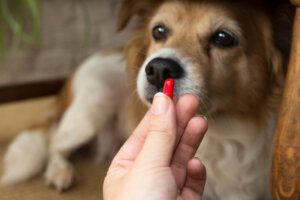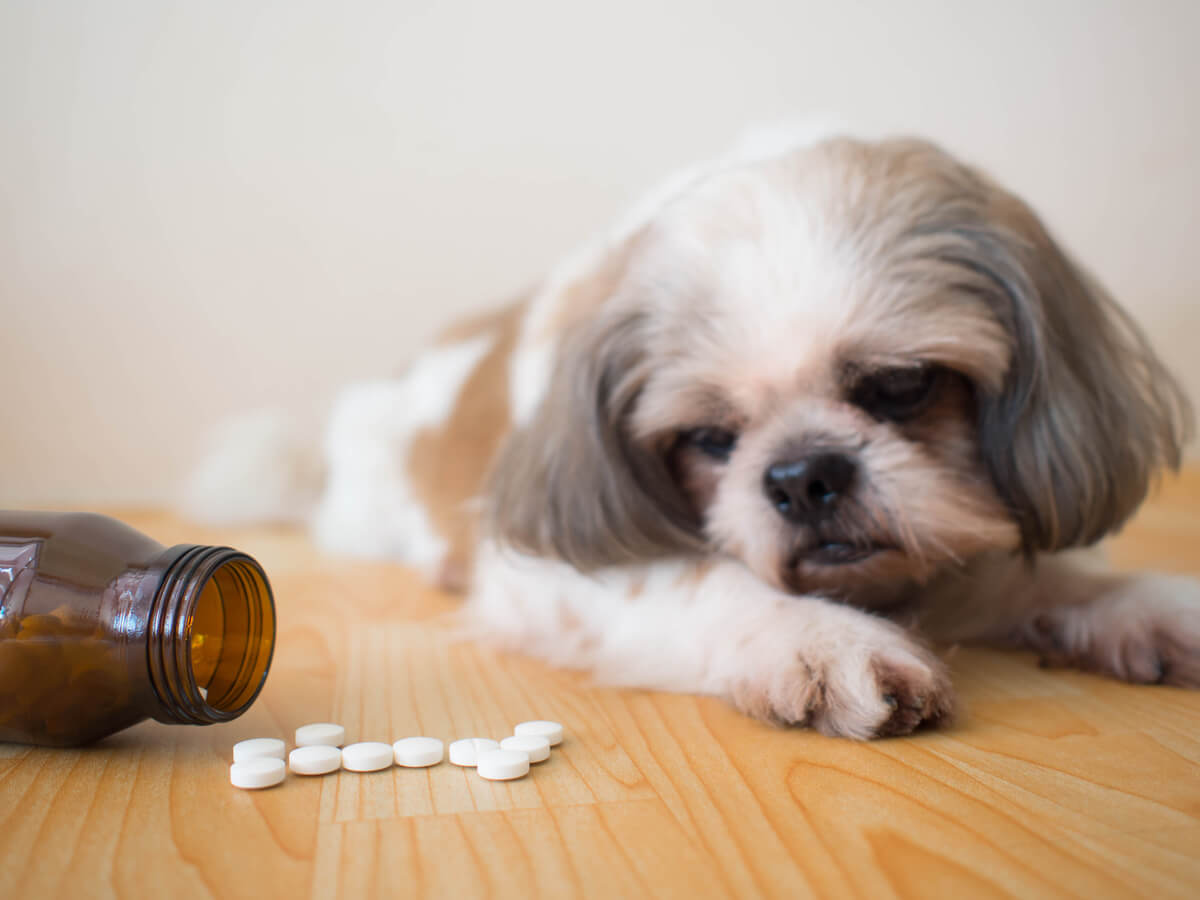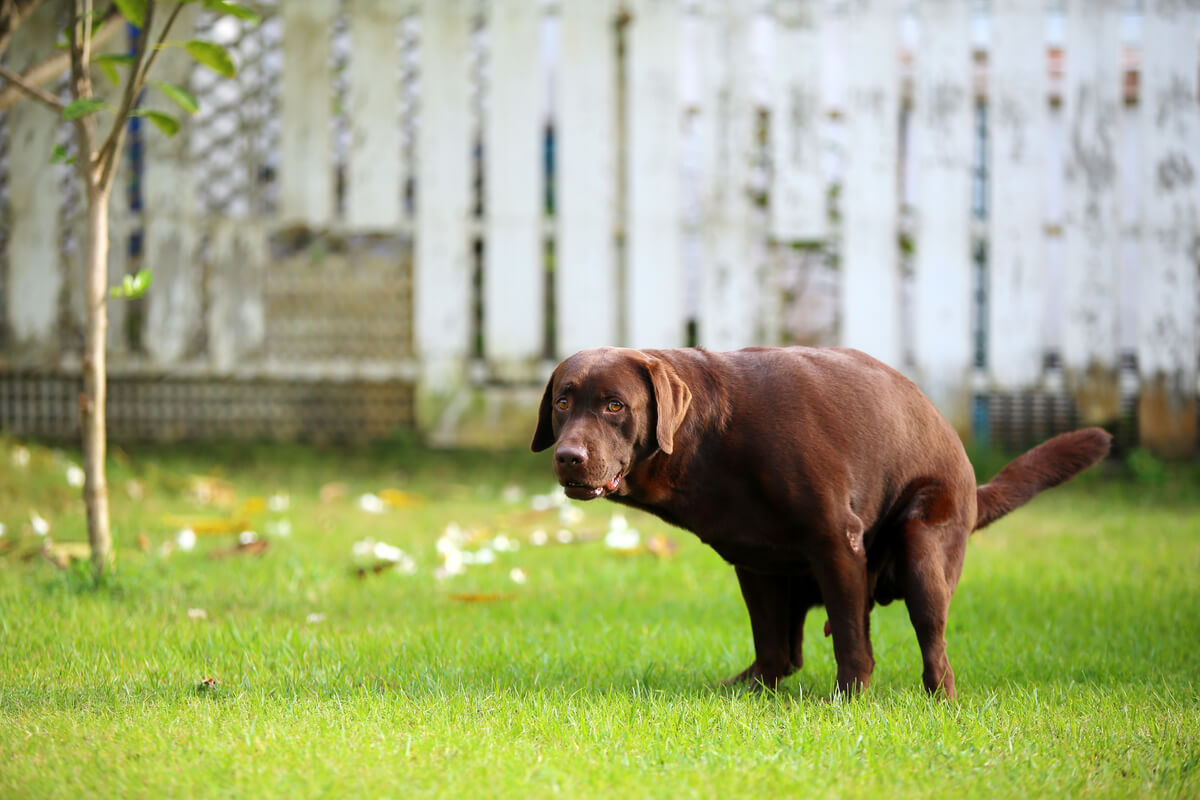Laxatives for Dogs: Dosage and Care


Written and verified by the biologist Ana Díaz Maqueda
Laxatives for dogs help your furry friend to defecate when, for whatever reason, it stops doing so regularly or begins to suffer constipation problems. These types of substances, whether they’re regulated drugs or natural products, should be used with caution and under veterinary supervision.
Medications that help dogs defecate can be administered orally or rectally. In principle, this is decided according to the part of the digestive tract where the blockage is. In the following article, we’ll look at different types of laxatives and how they’re used.
Constipation in dogs
Constipation in dogs is a serious problem that must be differentiated from other digestive disorders or irregularities when defecating. A constipated dog is one that tries to defecate, but can’t. The condition must be maintained for a few days before it becomes a cause for concern.
The causes of constipation in dogs can be many, from psychological problems – such as fear or stress – to serious physical disorders, such as tumors in the intestines or other adjoining organs. Also, a diet poor in fiber with irregular water consumption can cause constipation in dogs. Among the main symptoms of this problem are:
- A hard abdomen
- Small, hard, or dry stools
- Excessive straining during bowel movements
- A lack of appetite (uncommon)
- A change in posture (stooped)
- Vomiting
Read more: Five Ways to Solve Dog Constipation
Treatment of constipation in dogs
When an owner detects that the pet is constipated, the best thing to do is to visit the veterinarian for assessment. In many cases, if the problem isn’t too severe, a simple change of diet and a bit more exercise is enough to eliminate the retained stools.
However, sometimes the triggering cause of constipation isn’t so easily solved and may require extra support. This is where laxatives and enemas come into play.
Types of laxatives for dogs and recommended dosages
Laxatives are drugs that remove stool blockages that are located somewhere in the intestine. These drugs can act in 5 different ways:
- Emollients: The active ingredient is a surfactant substance, whose mechanism of action is based on eliminating the surface tension of the stool and allowing it to hydrate, thus allowing it to pass better through the digestive tract.
- Lubricants or bulk softeners: These prevent the colon from absorbing water, which allows the stools to stay hydrated and pass easily.
- Hyperosmotics: These stimulate fluid secretion in the colon and facilitate stool motility. This leads to a constant loss of water, so they shouldn’t be used in dehydrated animals.
- Stimulants: As their name implies, they directly stimulate the intestine to perform the peristaltic movement. In addition, it reduces the absorption of liquids, thus keeping the feces wetter.
- Bulk-formers: Other laxatives have the ability to create new, highly hydrated, and bulky stools to help eliminate the clogging.
Choosing one drug or another will depend on the decision made by the veterinarian who is treating your dog. This choice is made bearing in mind several factors, such as the size of the fecal accumulation or the length of time the animal has been constipated.
In veterinary medicine, three types of laxatives are used: lubricants, osmotic, and stimulants of peristalsis movement that help to encourage the transit of feces in the intestine. Below are some examples of each of the types of laxatives for dogs, as well as the recommended dosage according to the original product insert.

1. Paraffin oil
This is a type of lubricant laxative. It works in a way that lubricates the walls of the intestine and softens the stool (like an emollient) to facilitate its expulsion. The recommended dose of this product is 5 milliliters per 5 kilograms of body weight of the dog.
2. Lactulose
This is a disaccharide (sugar) osmotic laxative and ammonia reducer. It’s often used to reduce ammonia levels when there are liver problems in humans. In pets, it’s used to soften stool and treat constipation. The recommended dose is 0.6 milliliters per kilogram of the dog’s body weight.
3. Bisacodyl
This is a substance that acts as a stimulant of the intestine’s peristaltic movements. However, when the treatment is prolonged too long in time, it can interfere with the function of the colon. The recommended dosage is usually between 5 and 20 milligrams per day.
Combining laxatives with enemas in dogs
When constipation is more severe, but is very close to the rectum, the use of enemas may be recommended. An enema consists of introducing liquid or some drug through the animal’s anus, with the intention of emptying the rectum and colon.
In the case of dogs, the most commonly used enema is kerosene or soapy solutions. With the animal fully anesthetized and intubated – to prevent aspiration pneumonia with its own saliva – the edema is introduced through the anus.
If it’s done immediately, after a few hours the animal will defecate and expel everything it has retained. On the other hand, during the application of the edema, the veterinarian may opt for a manual removal of the feces if they’re close to the anus.
In cases of fecal impaction where the feces have become too hard, there’s no problem with combining the use of laxative and edema. However, before using any type of edema, the animal must be fully hydrated. This will prevent the substance administered from being absorbed through the wall of the intestine.
5 natural laxatives for dogs
When a dog begins to have smaller, harder stools, it may be time to try a natural laxative to prevent constipation. Some foods that can have a laxative effect on dogs are as follows.
1. Milk
Milk, in large amounts, can act as a laxative, as it contains lactose. Lactose is a type of sugar that is broken down by lactase (enzyme) in the small intestine. However, most adult dogs lack this enzyme. So when a dog drinks too much milk, the lactose accumulates and is eventually expelled in the form of diarrhea.
Although it’s a natural product, milk can pose a danger to the animal, due to the risk of dehydration. Never use this remedy without consulting a veterinarian.
2. Olive oil
Olive oil and other vegetable oils, being lipid compounds, have a delayed digestion that begins with the segregation of the food into lipid microdroplets. These help to hydrate the intestinal walls and push the stools out.
3. Pumpkin
Pumpkins seem to a laxative effect on dogs. In small quantities – and always well cooked – pumpkin is a help for dogs that tend to have constipation.
4. Water
At the end of the digestive process – and during the formation of feces – the waste that reaches the large intestine is loaded with water. At this point in the digestive tract, the water is absorbed so that the feces are formed and expelled.
A dog that takes in too little water will produce more compact and dry stools, because the intestine cannot allow this liquid to be lost. Therefore, to make it easier for the stool to stay hydrated and because the body doesn’t tend to absorb all the water, the dog should drink more.
5. Exercise
Another good natural laxative is physical exercise. Keeping the body active helps the correct peristaltic movement. In addition, if the dog exercises and gets hot, it will tend to drink more water which, in turn, will help the correct formation of stools.
Read more: Can Your Dog Eat Yogurt?

As always, the best treatment is prevention. Making the animal have an active life, a good diet and proper rest is the key to proper intestinal health in the pet.
Laxatives for dogs help your furry friend to defecate when, for whatever reason, it stops doing so regularly or begins to suffer constipation problems. These types of substances, whether they’re regulated drugs or natural products, should be used with caution and under veterinary supervision.
Medications that help dogs defecate can be administered orally or rectally. In principle, this is decided according to the part of the digestive tract where the blockage is. In the following article, we’ll look at different types of laxatives and how they’re used.
Constipation in dogs
Constipation in dogs is a serious problem that must be differentiated from other digestive disorders or irregularities when defecating. A constipated dog is one that tries to defecate, but can’t. The condition must be maintained for a few days before it becomes a cause for concern.
The causes of constipation in dogs can be many, from psychological problems – such as fear or stress – to serious physical disorders, such as tumors in the intestines or other adjoining organs. Also, a diet poor in fiber with irregular water consumption can cause constipation in dogs. Among the main symptoms of this problem are:
- A hard abdomen
- Small, hard, or dry stools
- Excessive straining during bowel movements
- A lack of appetite (uncommon)
- A change in posture (stooped)
- Vomiting
Read more: Five Ways to Solve Dog Constipation
Treatment of constipation in dogs
When an owner detects that the pet is constipated, the best thing to do is to visit the veterinarian for assessment. In many cases, if the problem isn’t too severe, a simple change of diet and a bit more exercise is enough to eliminate the retained stools.
However, sometimes the triggering cause of constipation isn’t so easily solved and may require extra support. This is where laxatives and enemas come into play.
Types of laxatives for dogs and recommended dosages
Laxatives are drugs that remove stool blockages that are located somewhere in the intestine. These drugs can act in 5 different ways:
- Emollients: The active ingredient is a surfactant substance, whose mechanism of action is based on eliminating the surface tension of the stool and allowing it to hydrate, thus allowing it to pass better through the digestive tract.
- Lubricants or bulk softeners: These prevent the colon from absorbing water, which allows the stools to stay hydrated and pass easily.
- Hyperosmotics: These stimulate fluid secretion in the colon and facilitate stool motility. This leads to a constant loss of water, so they shouldn’t be used in dehydrated animals.
- Stimulants: As their name implies, they directly stimulate the intestine to perform the peristaltic movement. In addition, it reduces the absorption of liquids, thus keeping the feces wetter.
- Bulk-formers: Other laxatives have the ability to create new, highly hydrated, and bulky stools to help eliminate the clogging.
Choosing one drug or another will depend on the decision made by the veterinarian who is treating your dog. This choice is made bearing in mind several factors, such as the size of the fecal accumulation or the length of time the animal has been constipated.
In veterinary medicine, three types of laxatives are used: lubricants, osmotic, and stimulants of peristalsis movement that help to encourage the transit of feces in the intestine. Below are some examples of each of the types of laxatives for dogs, as well as the recommended dosage according to the original product insert.

1. Paraffin oil
This is a type of lubricant laxative. It works in a way that lubricates the walls of the intestine and softens the stool (like an emollient) to facilitate its expulsion. The recommended dose of this product is 5 milliliters per 5 kilograms of body weight of the dog.
2. Lactulose
This is a disaccharide (sugar) osmotic laxative and ammonia reducer. It’s often used to reduce ammonia levels when there are liver problems in humans. In pets, it’s used to soften stool and treat constipation. The recommended dose is 0.6 milliliters per kilogram of the dog’s body weight.
3. Bisacodyl
This is a substance that acts as a stimulant of the intestine’s peristaltic movements. However, when the treatment is prolonged too long in time, it can interfere with the function of the colon. The recommended dosage is usually between 5 and 20 milligrams per day.
Combining laxatives with enemas in dogs
When constipation is more severe, but is very close to the rectum, the use of enemas may be recommended. An enema consists of introducing liquid or some drug through the animal’s anus, with the intention of emptying the rectum and colon.
In the case of dogs, the most commonly used enema is kerosene or soapy solutions. With the animal fully anesthetized and intubated – to prevent aspiration pneumonia with its own saliva – the edema is introduced through the anus.
If it’s done immediately, after a few hours the animal will defecate and expel everything it has retained. On the other hand, during the application of the edema, the veterinarian may opt for a manual removal of the feces if they’re close to the anus.
In cases of fecal impaction where the feces have become too hard, there’s no problem with combining the use of laxative and edema. However, before using any type of edema, the animal must be fully hydrated. This will prevent the substance administered from being absorbed through the wall of the intestine.
5 natural laxatives for dogs
When a dog begins to have smaller, harder stools, it may be time to try a natural laxative to prevent constipation. Some foods that can have a laxative effect on dogs are as follows.
1. Milk
Milk, in large amounts, can act as a laxative, as it contains lactose. Lactose is a type of sugar that is broken down by lactase (enzyme) in the small intestine. However, most adult dogs lack this enzyme. So when a dog drinks too much milk, the lactose accumulates and is eventually expelled in the form of diarrhea.
Although it’s a natural product, milk can pose a danger to the animal, due to the risk of dehydration. Never use this remedy without consulting a veterinarian.
2. Olive oil
Olive oil and other vegetable oils, being lipid compounds, have a delayed digestion that begins with the segregation of the food into lipid microdroplets. These help to hydrate the intestinal walls and push the stools out.
3. Pumpkin
Pumpkins seem to a laxative effect on dogs. In small quantities – and always well cooked – pumpkin is a help for dogs that tend to have constipation.
4. Water
At the end of the digestive process – and during the formation of feces – the waste that reaches the large intestine is loaded with water. At this point in the digestive tract, the water is absorbed so that the feces are formed and expelled.
A dog that takes in too little water will produce more compact and dry stools, because the intestine cannot allow this liquid to be lost. Therefore, to make it easier for the stool to stay hydrated and because the body doesn’t tend to absorb all the water, the dog should drink more.
5. Exercise
Another good natural laxative is physical exercise. Keeping the body active helps the correct peristaltic movement. In addition, if the dog exercises and gets hot, it will tend to drink more water which, in turn, will help the correct formation of stools.
Read more: Can Your Dog Eat Yogurt?

As always, the best treatment is prevention. Making the animal have an active life, a good diet and proper rest is the key to proper intestinal health in the pet.
All cited sources were thoroughly reviewed by our team to ensure their quality, reliability, currency, and validity. The bibliography of this article was considered reliable and of academic or scientific accuracy.
- Binder, H. J. (1977). Pharmacology of laxatives. Annual review of pharmacology and toxicology, 17(1), 355-367.
- Tzimtzimis, E., Papazoglou, L., Patsikas, M., Tsioli, V., Kouti, V., Konstantinidis, A., & Rallis, T. (2019). Colonic impaction in dogs: a retrospective study of 58 cases (1996 to 2014). Journal of Small Animal Practice, 60(7), 444-449.
- Wald, A. (2003). Is chronic use of stimulant laxatives harmful to the colon?. Journal of clinical gastroenterology, 36(5), 386-389.
- Ward, E. (2016). VCA Hospitals. Constipation in Dogs. Recuperado el 26 de febrero de 2023, disponible en: https://vcahospitals.com/know-your-pet/constipation-in-dogs
- Washington, N., Harris, M., Mussellwhite, A., & Spiller, R. C. (1998). Moderation of lactulose-induced diarrhea by psyllium: effects on motility and fermentation. The American journal of clinical nutrition, 67(2), 317-321.
- Richter, K. P., & Cleveland, M. V. (1989). Comparison of an orally administered gastrointestinal lavage solution with traditional enema administration as preparation for colonoscopy in dogs. Journal of the American Veterinary Medical Association, 195(12), 1727-1731.
- Zentek, J., Marquart, B., & Pietrzak, T. (2002). Intestinal effects of mannanoligosaccharides, transgalactooligosaccharides, lactose and lactulose in dogs. The Journal of nutrition, 132(6), 1682S-1684S.
This text is provided for informational purposes only and does not replace consultation with a professional. If in doubt, consult your specialist.








